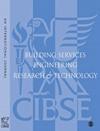静态网格碳因子-我们能做得更好吗?
IF 1.8
4区 工程技术
Q3 CONSTRUCTION & BUILDING TECHNOLOGY
Building Services Engineering Research & Technology
Pub Date : 2021-05-01
DOI:10.1177/0143624421991964
引用次数: 1
摘要
英国国家电网提供的电力的平均碳强度(gCO2e/kWh)正在下降,并且时间变化越来越大。本文回顾了使用不同级别的数据分辨率(半小时、每天、每月和每年)以及转移到特定区域的数据对能源计算的影响。该分析分为两部分,一部分侧重于对L部分评估的潜在影响,另一部分则侧重于现有建筑的碳排放报告。分析表明,当使用使用更高分辨率网格碳强度数据的排放计算方法时,计算的排放量可能增加12%。区域分析表明,计算差异更大,一些地区的年排放量比其他地区增加了10倍。本文为该行业提供了一条前进的道路,通过使用更好的数据源来提高分析的准确性。计算方法的拟议变化类似于从使用年平均外部温度转变为使用特定城市的CIBSE天气概况或使用未来天气文件。实际应用:本文旨在量化行业中常用的计算方法的不准确性,以及建筑法规(特别是《建筑法规》第L部分——燃料和电力节约)的关键——将电力消耗转化为碳排放。它提出了一种替代方法,该方法基于改进的数据输入来提高计算的准确性。本文章由计算机程序翻译,如有差异,请以英文原文为准。
Static grid carbon factors – Can we do better?
The average carbon intensity (gCO2e/kWh) of electricity provided by the UK National Grid is decreasing and becoming more time variable. This paper reviews the impact on energy calculations of using various levels of data resolution (half hourly, daily, monthly and annual) and of moving to region specific data. This analysis is in two parts, one focused on the potential impact on Part L assessments and the other on reported carbon emissions for existing buildings. Analysis demonstrated that an increase in calculated emissions of up to 12% is possible when using an emissions calculation methodology employing higher resolution grid carbon intensity data. Regional analysis indicated an even larger calculation discrepancy, with some regions annual emissions increasing by a factor of ten as compared to other regions. This paper proposes a path forward for the industry to improve the accuracy of analysis by using better data sources. The proposed change in calculation methodology is analogous to moving from using an annual average external temperature to using a CIBSE weather profile for a specific city or using a future weather file. Practical application: This paper aims to quantify the inaccuracy of a calculation methodology in common use in the industry and key to building regulations (specifically Building Regulations Part L – Conservation of Fuel and Power) – translating electricity consumption into carbon emissions. It proposes an alternative methodology which improves the accuracy of the calculation based on improved data inputs.
求助全文
通过发布文献求助,成功后即可免费获取论文全文。
去求助
来源期刊

Building Services Engineering Research & Technology
工程技术-结构与建筑技术
CiteScore
4.30
自引率
5.90%
发文量
38
审稿时长
>12 weeks
期刊介绍:
Building Services Engineering Research & Technology is one of the foremost, international peer reviewed journals that publishes the highest quality original research relevant to today’s Built Environment. Published in conjunction with CIBSE, this impressive journal reports on the latest research providing you with an invaluable guide to recent developments in the field.
 求助内容:
求助内容: 应助结果提醒方式:
应助结果提醒方式:


